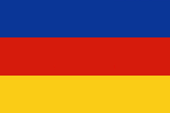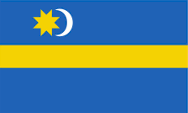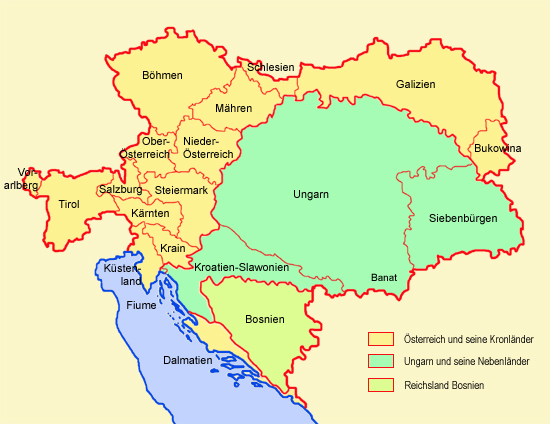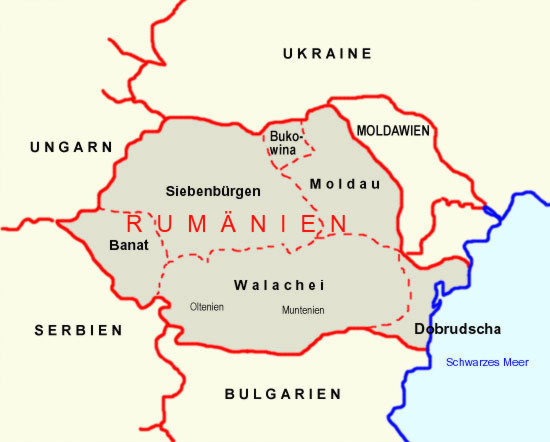mobile View, to the German Version tap the flag


- Transylvania (Siebenbürgen, Siebenburgen)
- former Hungarian crown land "Grand Principality of Siebenbuergen" and Province in the Carpatian Mountains
- since 1920 to Romania
- own names: German: Siebenburgen, Hungarian: Erdély, Romanian: Ardeal, Transsilvania
• Flag
• Flags of some Minorities
• Meaning/Origin of the Flag
• Coat of Arms
• Meaning/Origin of the Coat of Arms
• Map
• Numbers and Facts
• History
• Origin of the Country's Name

Colours of the country,
ratio = 2:3,
Source, by: Flags of the World






Flag of the National Council of the Székelys,
Source, by: Wikipedia (D)




Flag of the Székelys in the area of Csíkszék,
Source, by: Adam & Wikipedia (HU)




Coat of arms of the Transylvanian Saxons,
Source, by: Wikipedia (D)


The colours of Transylvania (Siebenburgen) show three horizontal stripes in blue, red and gold. The colours have their roots in the blazon of the country. It is divided by a red bar between blue and gold. The most famous national minorities are the Székelys (sometimes called Hungarians, which is not entirely correct) and the Transylvanian Saxons. The Szekler are even in the majority in some regions of Transylvania, the Transylvanian Saxons have emigrated in large numbers. The Székelys have their own flags, such as the flag of the National Council, a political organization whose flag goes back to the historical flag of the Székelys. Furthermore, there appears to be a red, gold and black flag. The Saxons do not have their own flag, only coats of arms.
Source: Flags of the World,
austria-forum.org,
Volker Preuß


to 1918,
Coat of arms of the Grand Principality of Siebenburgen,
Source, by:
austria-forum.org

The coat of arms of Siebenburgen is divided by a red bar between blue and gold. In the blue field the upper half of a black eagle, sun and moon to the left and to the right. The eagle stands for the Hungarians, the moon and sun stand for the Székelys and the seven red castles represent the Transylvanian Saxons (seven castles = sieben Burgen). Transylvania is represented with this heraldry in the Romanian coat of arms since 1921.
Source: Wikipedia (D),
Flags of the World,
austria-forum.org,
Volker Preuß

interaktive Map of Austria-Hungary, ca. 1910:

Source:
Volker Preuß
Historical regions of Romania:

Source: Volker Preuß

Area: 21.518 square miles
Inhabitants 1880: 4.033.000, thereof 57% Romanians (Walachians), 26% Hungarians (Székelys), 12% Germans (Transylv. Saxons), 2% Gipsies
Inhabitants 2011: 6.789.250, thereof 71% Romanians (Walachians), 18% Hungarians (Székelys), 4% Gipsies, 0,4% Germans (Transylv. Saxons)
Density of Population 2011: 315 inh./sq.mi.
Capital: Klausenburg (rumänisch: Cluj-Napoca, ungarisch: Kolozsvár), 324.576 Ew. (2011)
Sprachen: Romanian, Hungarian, German
Time Zone: MEZ + 1 h
Source: Wikipedia (D)

ca. 1st cent. A.D. · part of the Country of Dakia
107 · Roman conquest under Trajan
274 · withdrawal of the Romans, remain of some Dako-roman population
5th to 6th cent. · to the Empire of the Gepids
6th cent. · to the Empire of the Awars
9th cent. · to the Empire of the Hungarians
1150 · the Hungarian King Géza II. calls for Germans ("Siebenburgen/ Transylvanian Saxons") as farmers and miners, settlement on by the King distributed plots ("King's Ground")
1211 · the Order of Teutonic Knights takes seat in the Burzen Land (region around Kronstadt/Brasov)
1224 · decree of the "Golden Licence" for the Germans, through there granting of autonomy and some privileges
1225 · the Order of Teutonic Knights leaves the Burzen Land
12th cent. to 13th cent. · immigration of Romans
1240 · Mongol invasion
1421 · Turk attack
1433 · Turk attack
1526 · Battle of Mohács, death of the Hungarian King Ludwig II., the House of Habsburg inherits the Hungarian crown, Johann Zápolya nominates itself to opposite king
1530 · Johann Zápolya and its supporters conquer Siebenburgen
1540 · death of Johann Zápolya, his son Johann Siegmund becomes proclaimed to the King of Hungary
1541 · Johann Siegmund calls out for the Turks, Siebenburgen becomes dependent from the Ottoman Empire
1571 · death of Johann Siegmund, election of Stephan Báthori to the Prince of Siebenburgen
1576 · Stephan Báthori becomes elected to the King of Poland, his brother Christoph Báthori becomes the successor as Prince of Siebenburgen
1581 · death of Christoph Báthori, successor is his son Siegmund Báthori
1599 · Siegmund Báthori renounces in favour of his cousin Andreas Báthori, assassination of Andreas Báthori by the Duke Michael of the Valachy, Emperor Rudolph of Habsburg takes over the regency, but Stephan Bocskay becomes confirmed by the Turkish Sultan as self proclaimed Prince of Siebenburgen
23.06.1606 · Peace of Vienna, treaty of peace between Hungary and Siebenburgen, in this way recognition of Stephan Bocskay as Prince of Siebenburgen
29.16.1606 · death of Stephan Bocskay, election of Siegmund Rákóczy to the prince
1608 · Siegmund Rákóczy resigns, election of his cousin Gabriel Báthori to the Prince of Siebenburgen, establishment of a reign of terror
1613 · assassination of Gabriel Báthori, election of Gabriel Bethlen to the Prince of Siebenburgen
1629 · death of Gabriel Bethlen, regency of his wife Katharina of Brandenburg
1631 · Katharina of Brandenburg resigns, election of Georg Rákóczy I. of the prince
1644 · alliance with France and Sweden against the Roman-German emperor, gain of territory by concessions of the emperor
1648 · death of Georg Rákóczy I., succession by his son Georg Rákóczy II.
9th of June 1660 · death of Georg Rákóczy II. after the battle of Klausenburg against the by the Turks promoted rival Achat Barcsai, election of Johann Kemény to the prince
April 1661 · capture and execution of Achat Barcsai, campaigns of the Turks, the Turks install Michael Apafi as Prince of Siebenburgen
28th of January 1662 · death of Johann Kemény in the Battle of Nagy Szöllös against the Turks
1683 · annihilation of the Turks in front of Vienna, march in of imperial troops, Michael Apafi becomes forced to conventions with the emperor
1688 · the parliament of Siebenburgen recognizes the supremacy of the Hungarian king and the Roman-German emperor
1690 · death of Michael Apafi, succession by his son Michael Apafi II.
4th of December 1691 · coming into force of the "Leopoldinian Diploma", a kind of constitution and basic treaty with the House of Habsburg
1696 · Prince Michael Apafi II. resigns in favour of the Roman-German emperor
1697 · Battle of Karlowitz, the Turks have to cede Hungary, Slavonia, Croatia and the Principality of Siebenbuergen to the House of Habsburg
1699 · Peace of Karlowitz, the Ottoman Empire recognizes the Roman-German emperor as Prince of Siebenburgen, end of the Turkish control
1703–1711 · rebellion of the Franz Rákóczy, proclamation to the Prince of Siebenburgen, support by the Hungarian nobility
1711 · Peace of Szathmár between the Roman-German emperor and the Hungarians, Rákóczy goes in exile
21st of July 1718 · Peace of Poscharewatz, the Ottoman Empire has after attacks to recognize again the Roman-German emperor as Prince of Siebenburgen und in this way also the rule of the Habsburgs over the country
1765 · the Roman-German Empress Maria Theresia levies Siebenburgen to a grand principality
1782 · riots of the Romanians
1825 · arise of Hungarian nationalistic, Great Hungarian and liberal (anti-monarchistic) movements
5th of February 1835 · dissolution of the parliament
1848 · revolutionar agitations and civil war (Hungarians against Romanians)
4th of March 1849 · new Austrian imperial constitution, Siebenburgen/ Transylvania becomes a crown land of the Austrian monarchy with an own parliament
17th of February 1867 · the parliament of Siebenburgen passes with its Hungarian majority the connection to the Hungarian monarchy, Siebenburgen becomes an Hungarian province and the parliament becomes dissolved
1st of January 1868 · sharing out of Siebenburgens in districts (Comitats), abolition of all autonomy regulations
1914–1918 · First World War
1st of November 1918 · Hungary proclaims its independence from Austria
13th of November 1918 · Karl IV. (Karl I.) renounces temporaryly in Hungary for the exertion of his reign, end of the Habsburg monarchy
4th of June 1920 · Peace of Trianon, Siebenburgen becomes annexed to Romania
1939–1945 · Second World War
1940 · Second Arbitration Award of Vienna, Romania has to cede Northern Siebenburgen to Hungary
22nd of June 1941 · Romania joines the side of the der Axis in the Second World War
24th of August 1944 · Romania leaves the Axis
25th of August 1944 · Romania declares the German Empire the war
1944 · resettlement of Siebenburgen Saxons from Northern Siebenburgen in the German Empire
1947 · Hungary has to cede Northern Siebenburgen to Romania, deoprtation of a lot of Siebenburgen Saxons from Sothern Siebenburgen to Russia
1952 · autonomy rights for the Siebenburgen/ Transylvanian Hungarians
1989–1992 · exodus of a lot of Siebenburgen/ Transylvanian Saxons to Germany
Source: Atlas zur Geschichte,
Wikipedia (D),
World Statesmen,
RetroBib Retrobibliothek,
Discovery '97,
Weltgeschichte,
Volker Preuß

Siebenburgen was named in the middle ages in Latin "Terra ultra silvas" (Country beyond the Forests), "Partes ultrasilvanae" (Territories beyond the Forest) and later "Transsilvania". The from the Romans descending and in Siebenburgen living Dako-Romances respectively the in the 12th and 13th century immigrating Romans (Romanians) took over the word "Transsilvania". The in the 9th century immigrating Hungarians (in Siebenburgen named "Szekler") used for Siebenburgen initially the term "Erdö Elve" (Erdö means forest) what later became "Erdély". The Romanians took over that term as "Ardeal". The in the 12th century immigrating Germans ("Siebenburgen Saxons") from Flandern and the Rhenish Countries established many places and towns. The most important then was Hermannstadt. Except Hermannstadt in the course of times got seven further German towns an own judicial authority. Its names concluded (then) probably with -burg, e.g. Klausenburg, Schaessburg, Marienburg, Toerzburg etc. From there comes probably the German name of the country "Siebenburgen". The "Siebenburgen Saxons" were called for mining work. In the middle ages in whole Europe were named immigrated German miners mostly as "Saxons".
Source: Handbuch der geographischen Namen,
Wikipedia (D)


Kindly supported by: Jürgen Zens (D)
![]()














